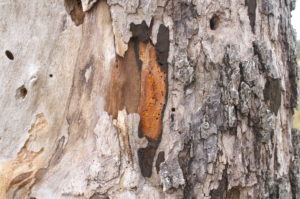 COMMON NAME: Hypoxylon Canker (of Sycamore)
COMMON NAME: Hypoxylon Canker (of Sycamore)
SCIENTIFIC NAME: Biscogniauxia atropunctatum
DISEASE DESCRIPTION
There are many kinds of Hypoxylon diseases of different trees, particularly when the trees are exposed to environmental stresses. The fungal pathogens causing Hypoxylon produce cankers, or discrete lesions, just under the bark of the tree. This disease is a worldwide problem on many different kinds of trees. For example, Hypoxylon canker of oaks is another, similar disease.
*BONUS* (Due to large number of students in this class). Additional information was gathered for other host. Check out:
SYMPTOMS
The earliest symptom of this disease is a noticeable thinning of the canopy. After this, there will be discoloration and sloughing off of bark accumulating in piles at the base of the tree. At this stage, the wood underneath the bark will become visible. This wood will appear to be light brown/tan and have a powdery appearance. The exposed wood and powdery coloration are the spores of the fungus. At this stage the tree is lost, but within a few weeks the powdery appearance will give way to dark splotches that will look like solidified asphalt or tar.
BIOLOGY
This disease is caused by a fungus that can live for prolonged periods of time in the tree without causing harm. The transition to being a problem happens when a tree undergoes stress (such as drought, physical damage). The visible portions of the fungus when powdery and light brown/tan are the asexual reproductive spores of the fungus (conidia). The transition to the dark black tar like growth is when the fungus transitions to its sexual reproductive stage. The black growth is actually the dark colored fruiting bodies (perithecia) containing the sexual spores (ascospores) of the fungus.
MANAGEMENT METHODS
The best defense against Hypoxylon is the proper care and maintenance of trees. By keeping the tree well-watered, fertilized, protected from pests and avoiding injuring the tree, one can greatly reduce the chance of the disease from developing. If the pathogen has been seen in a tree, properly pruning away any infected branches can greatly improve the survivability of the tree. Lastly, if a tree has succumbed and died from the disease, safely removing the tree will help prevent it from falling on people or property.
RESOURCE LINKS
McBride, S., and D.N. Appel. 2016. Hypoxylon Canker of Oaks. Publication No. EPLP-030. Texas A&M AgriLife Extension Service, Texas A&M University. (https://agrilifelearn.tamu.edu/SearchResults.asp?Search=Hypoxylon+Canker+of+Oaks&Submit=Search).
This link will take you to a more complete description of the disease and its management provided by the Texas A&M Forest Service.
This factsheet is authored by Cooper Svajda (Masters Molecular & Environmnetal Plant Sciences)
Factsheet information for the plant health issues represented by the images on the 2019 TPDDL calendar were written by graduate students enrolled in the Department of Plant Pathology & Microbiology PLPA601 Introductory Plant Pathology course in the 2018 Fall semester (course instructor: Dr. David Appel). This exercise provides an opportunity for a high impact learning activity where the students are tasked with producing an informational output directed to the general public and to provide opportunity for the students to write.